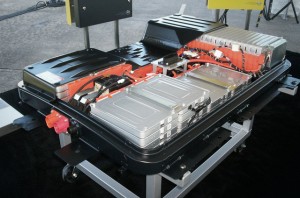Pike Research’s John Gartner forecasts that global sales of hybrid and electric cars will grow from 995,000 in 2011 to 2,870,000 in 2017. Half the hybrid cars and all of the EVs will use lithium battery packs by 2017. In fact, the latest hybrid cars from Ford, Buick, Honda, Hyundai and Kai use lithium batteries not nickel-metal hydride (NiMH). In six years, cars with advanced batteries will triple and lithium automotive battery packs will grow over 100 fold. The forecast is only for light-duty passenger vehicles and does not include 16 million cars expected by 2015 to be start-stop vehicles (SSV).
Pike Research’s optimism was shared by others at Infocast’s 10X Advanced Battery meeting which I attended to hear presentations from Pike Research, other research groups, battery makers, auto makers, and venture capitalists.
John Gartner forecasts that automotive lithium battery revenue will grow from $2 billion in 2011 to $14.6 billion in 2017. Because battery-electric vehicles (BEV) use much larger packs than hybrid-electric (HEV), 2017 BEV revenue will be $10.8 billion, PHEV will be 3.2 billion, and HEV will be 0.6 billion.
 Safety research continues. Much progress has been made in preventing lithium thermal runaways. In a crash test, the lithium battery in a Chevrolet Volt caught fire days after the crash. There have been no reported fires of actual owners including those involved in crashes. In contrast, there were over 180,000 fires in U.S. gasoline cars last year. The electric car alarmists continue to use their iPhones, Droids, iPads, and notebook computers that all use lithium batteries and do get dropped. We are not seeing a big demand for gasoline-powered smart phones.
Safety research continues. Much progress has been made in preventing lithium thermal runaways. In a crash test, the lithium battery in a Chevrolet Volt caught fire days after the crash. There have been no reported fires of actual owners including those involved in crashes. In contrast, there were over 180,000 fires in U.S. gasoline cars last year. The electric car alarmists continue to use their iPhones, Droids, iPads, and notebook computers that all use lithium batteries and do get dropped. We are not seeing a big demand for gasoline-powered smart phones.
Automotive lithium packs, including packaging, power electronics and thermal management, are forecast to drop from $752 per kilowatt hour (kWh) today to $523/kWh by 2017. At Clean Fleet Report, we speculate that automakers such as Tesla and Ford are already in that $500/kW ballpark today. Some are likely to reach $300/kW by 2020. Improved cell chemistry, hybrid car demand, and manufacturing volume will drive prices lower.
Will lithium batteries be a bubble like solar?
Solar cells are over 100 times cheaper than in the 1970s. We will not see such price drops for lithium, but prices will keep falling. Solar price drops in 2011 were great for homeowners and business that bought solar power, but the drops put several companies out of business. Solyndra met Darwin.
By 2017 it is possible that market share competition will lead to excess capacity and falling prices. Should that happen, packs would cost less than $500/kW. At the 10X meeting, patent attorney Matt Prater pointed out that Samsung, Panasonic, LG Chem, Toyota and Sony are leading in battery patents. The battle for market share is certain to be intense. Battery advancements for the automotive market will benefit stationary power and consumer electronics and vice versa.
Lithium is not the only game in town. Automakers continue to heavily use lead-acid batteries including improved chemistry for SSV. Many automakers, such as Toyota, continue to favor NiMH for hybrids for safety and cost reasons. Most electric cars use lithium batteries to supply the powertrain and lead-acid to support auxiliaries.
In this decade, lithium-ion is likely to dominate in electric and hybrid cars. The next decade is up in the air. Battery and automakers are actively researching solid-state batteries, magnesium, lithium-air and other metal air. General Motors is a stockholder in SAKTI3, which is making significant progress with solid-state technology that will lower battery size and cost. Toyota is actively researching magnesium, which is 24x cheaper than lithium and has better volumetric capacity. IBM and others are actively researching metal air batteries that could improve storage 10X with lithium-air. David Biello of Scientific American discusses alternatives such as flow batteries at Txchnologist.
Fuel cells are already commercialized in buses and forklifts. Several automakers plan to commercialize fuel-cell cars, crossovers, and SUVs in 2015 for fleets and consumers. This week I drove the Toyota FCHV, a Highlander SUV that uses a hydrogen fuel cell to extend the electric range to over 300 miles. The fuel cell works with the NiMH battery to supply electricity to the electric motor. I also drove the Mercedes B-Class F-CELL that extends electric range to 240 miles by utilizing a hydrogen fuel cell that works with its lii-ion battery. Both cars drove as smoothly and quietly as my Nissan LEAF.
Hyundai is making 2,000 Tucson FCV. The hydrogen fuel cells in these SUVs integrate an ultracapacitor into the fuel cell. More future cars may integrate ultracapacitors with advanced batteries and fuel cells. Different energy storage technology can complement – fuel cells have more energy density, capacitors more power density, and lithium batteries are in the middle of the two. Fuel cells complement li-ion batteries to extend car range. In automobiles, the long-term threats to li-ion batteries are solid-state, magnesium, and metal air.
The top 10 electric cars all use lithium-ion batteries to free drivers from stopping at gas stations. As electric and hybrid car competition intensifies, Nissan, GM, Toyota, and Ford are in a race to sell the most vehicles with lithium batteries. In 2013, at least one of these automakers will sell over 100,000 cars with lithium battery packs. In the future, advancements in cell chemistry and manufacturing volume will allow more hybrids to achieve over 40 miles per gallon, extend the range of electric cars, and make these advanced cars affordable for millions.

